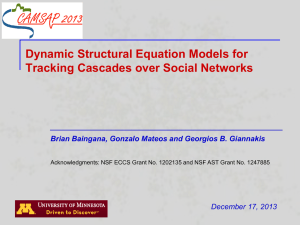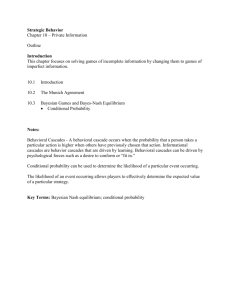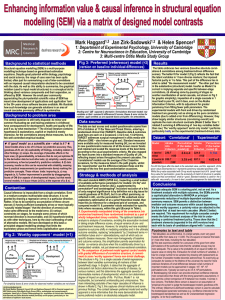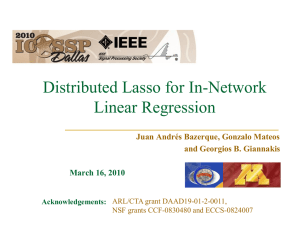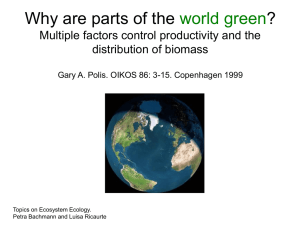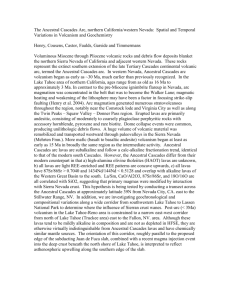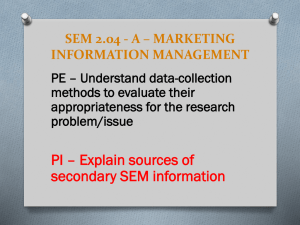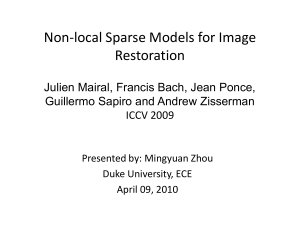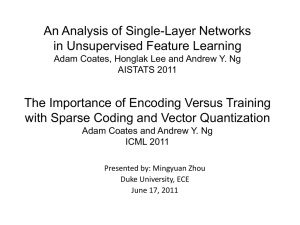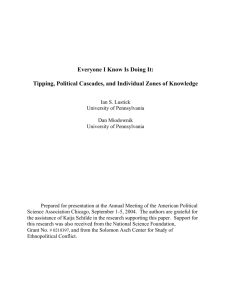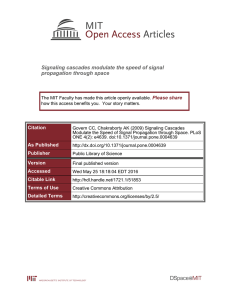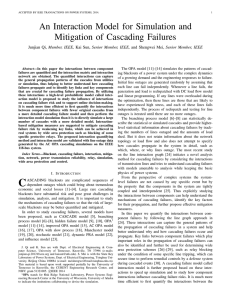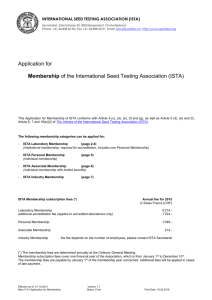Dynamic SEM
advertisement
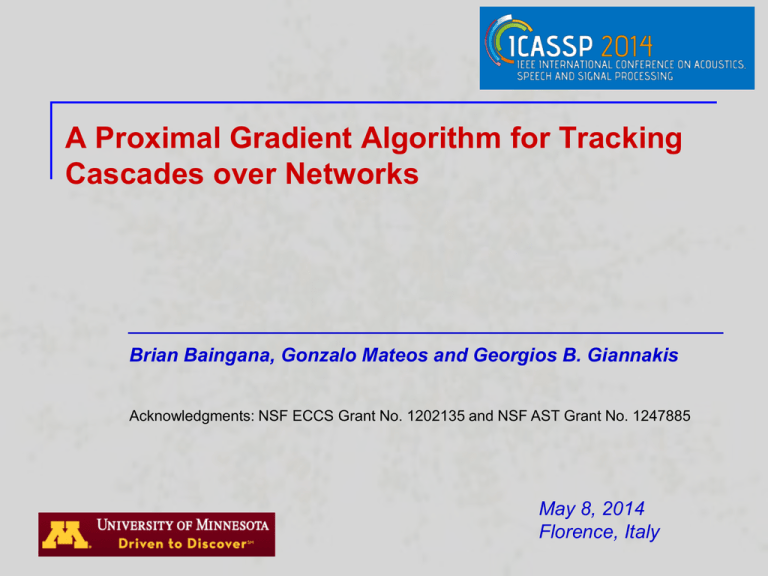
A Proximal Gradient Algorithm for Tracking Cascades over Networks Brian Baingana, Gonzalo Mateos and Georgios B. Giannakis Acknowledgments: NSF ECCS Grant No. 1202135 and NSF AST Grant No. 1247885 May 8, 2014 Florence, Italy Context and motivation Contagions Infectious diseases Buying patterns Popular news stories Network topologies: Unobservable, dynamic, sparse Propagate in cascades over social networks Topology inference vital: Viral advertising, healthcare policy Goal: track unobservable time-varying network topology from cascade traces B. Baingana, G. Mateos, and G. B. Giannakis, ``A proximal-gradient algorithm for tracking cascades over 2 social networks,'' IEEE J. of Selected Topics in Signal Processing, Aug. 2014 (arXiv:1309.6683 [cs.SI]). Contributions in context Structural equation models (SEM) [Goldberger’72] Statistical framework for modeling relational interactions (endo/exogenous effects) Used in economics, psychometrics, social sciences, genetics… [Pearl’09] Related work Static, undirected networks e.g., [Meinshausen-Buhlmann’06], [Friedman et al’07] MLE-based dynamic network inference [Rodriguez-Leskovec’13] Time-invariant sparse SEM for gene network inference [Cai-Bazerque-GG’13] Contributions Dynamic SEM for tracking slowly-varying sparse networks Accounting for external influences – Identifiability [Bazerque-Baingana-GG’13] First-order topology inference algorithm D. Kaplan, Structural Equation Modeling: Foundations and Extensions, 2nd Ed., Sage, 2009. 3 Cascades over dynamic networks N-node directed, dynamic network, C cascades observed over Unknown (asymmetric) adjacency matrices Example: N = 16 websites, C = 2 news events, T = 2 days Event #1 Event #2 Node infection times depend on: Causal interactions among nodes (topological influences) Susceptibility to infection (non-topological influences) 4 Model and problem statement Data: Infection time of node i by contagion c during interval t: un-modeled dynamics external influence Dynamic SEM Captures (directed) topological and external influences Problem statement: 5 Exponentially-weighted LS criterion Structural spatio-temporal properties Slowly time-varying topology Sparse edge connectivity, Sparsity-promoting exponentially-weighted least-squares (LS) estimator (P1) Edge sparsity encouraged by -norm regularization with Tracking dynamic topologies possible if 6 Topology-tracking algorithm Iterative shrinkage-thresholding algorithm (ISTA) [Parikh-Boyd’13] Ideal for composite convex + non-smooth cost Let gradient descent (P2) Solvable by soft-thresholding operator [cf. Lasso] -γ γ Attractive features Provably convergent, closed-form updates (unconstrained LS and soft-thresholding) Fixed computational cost and memory storage requirement per Scales to large datasets 7 Recursive updates Sequential data terms in recursive updates : row i of Each time interval Recursively update Acquire new data Solve (P2) using (F)ISTA 8 Simulation setup Kronecker graph [Leskovec et al’10]: N = 64, seed graph Non-zero edge weights varied for 1 0.5 Uniform random selection from 0 0 20 40 60 80 100 120 140 160 180 200 0 20 40 60 80 100 120 140 160 180 200 0 20 40 60 80 100 120 140 160 180 200 0 20 40 60 80 100 120 140 160 180 200 1 edge weight 0.5 0 1 0.5 0 1 0 Non-smooth edge weight variation cascades, −1 time , 9 Simulation results Algorithm parameters 20 20 40 40 60 60 20 40 actual, t=20 60 20 40 inferred, t=20 20 20 40 40 60 60 20 40 actual, t=180 60 60 20 40 60 inferred, t=180 Error performance 10 The rise of Kim Jong-un Web mentions of “Kim Jong-un” tracked from March’11 to Feb.’12 Kim Jong-un – Supreme leader of N. Korea N = 360 websites, C = 466 cascades, T = 45 weeks Increased media frenzy following Kim Jong-un’s ascent to power in 2011 t = 10 weeks t = 40 weeks Data: SNAP’s “Web and blog datasets” http://snap.stanford.edu/infopath/data.html 11 LinkedIn goes public Tracking phrase “Reid Hoffman” between March’11 and Feb.’12 N = 125 websites, C = 85 cascades, T = 41 weeks US sites t = 5 weeks t = 30 weeks Datasets include other interesting “memes”: “Amy Winehouse”, “Syria”, “Wikileaks”,…. Data: SNAP’s “Web and blog datasets” http://snap.stanford.edu/infopath/data.html 12 Conclusions Dynamic SEM for modeling node infection times due to cascades Topological influences and external sources of information diffusion Accounts for edge sparsity typical of social networks Proximal gradient algorithm for tracking slowly-varying network topologies Corroborating tests with synthetic and real cascades of online social media Key events manifested as network connectivity changes Ongoing and future research Dynamical models with memory Identifiabiality of sparse and dynamic SEMs Statistical model consistency tied to Large-scale MapReduce/GraphLab implementations Kernel extensions for network topology forecasting Thank You! 13 ISTA iterations PG iterations with equality constraints yield the (pseudo) real-time tracking algorithm: T als. R equir e: Y t t= 1, X , β. ˆ 0 = 0N × N , Bˆ 0 = Σ 0 = I N , Y¯ 0 = 0N × C , λ 0. 1: Initialize A 2: for t = 1, . . . , T do 3: Σ t = βΣ t− 1 + Y t (Y t )⊤ Recursive Updates 4: Y¯ t = β Y¯ t− 1 + Y t 5: Initialize A [0] = Aˆ t− 1, B [0] = Bˆ t− 1, and set k = 0. 6: while not converged do 7: for i = 1. . . N (in parallel) do 8: a− i [k + 1] = Sλ t / L f a− i [k] − (1/ L f )∇ a− i f [k] Parallelizable 9: bi i [k + 1] = bi i [k] − (1/ L f )∇ bi i f [k] 10: a⊤ i [k + 1] = [a− i ,1[k + 1] . . . a− i ,i − 1[k + 1] 0 a− i ,i [k + 1] . . . a− i ,N [k + 1]] 11: end for 12: k = k + 1. 13: end while 14: r et ur n Aˆ t = A [k], Bˆ t = B [k]. 15: end for A t t r act ive feat ur es of t he algor it hm : for 1. Provably guaranteed convergence 14 ADMM iterations Sequential data terms: , , can be updated recursively: denotes row i of 15 ADMM closed-form updates Update with equality constraints: , : Update by soft-thresholding operator 16 Outlook: Indentifiability of DSEMs a1) edge sparsity: a2) sparse changes: a3) error-free DSEM: Goal: under a1)-a3), establish conditions on to uniquely identify Preliminary result (static SEM) If , with and diagonal matrix and i) , ii) non-zero entries of are drawn from a continuous distribution, and iii) Kruskal rank , then and can be uniquely determined. J. A. Bazerque, B. Baingana, and G. B. Giannakis, "Identifiability of sparse structural equation models for directed, cyclic, and time-varying networks," Proc. of Global Conf. on Signal and Info. Processing, Austin, TX, December 3-5, 2013. 17
